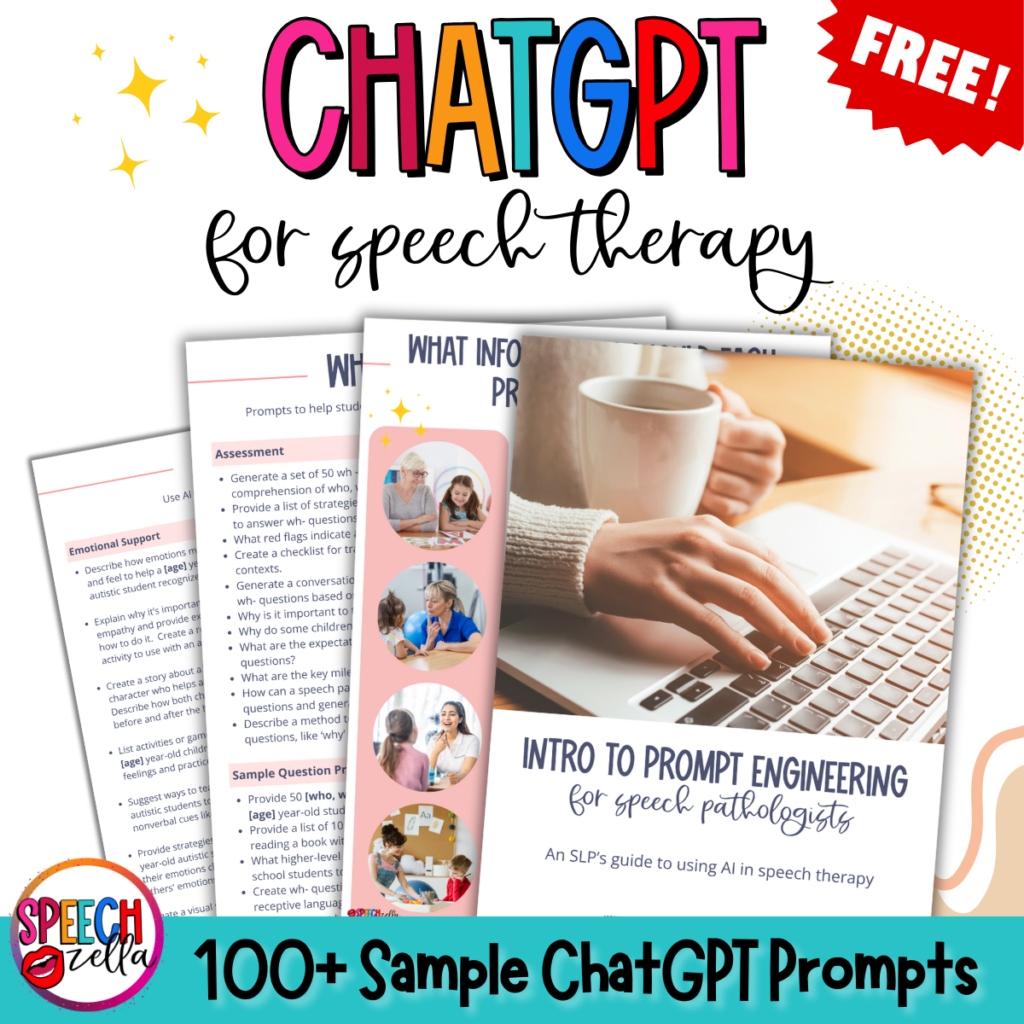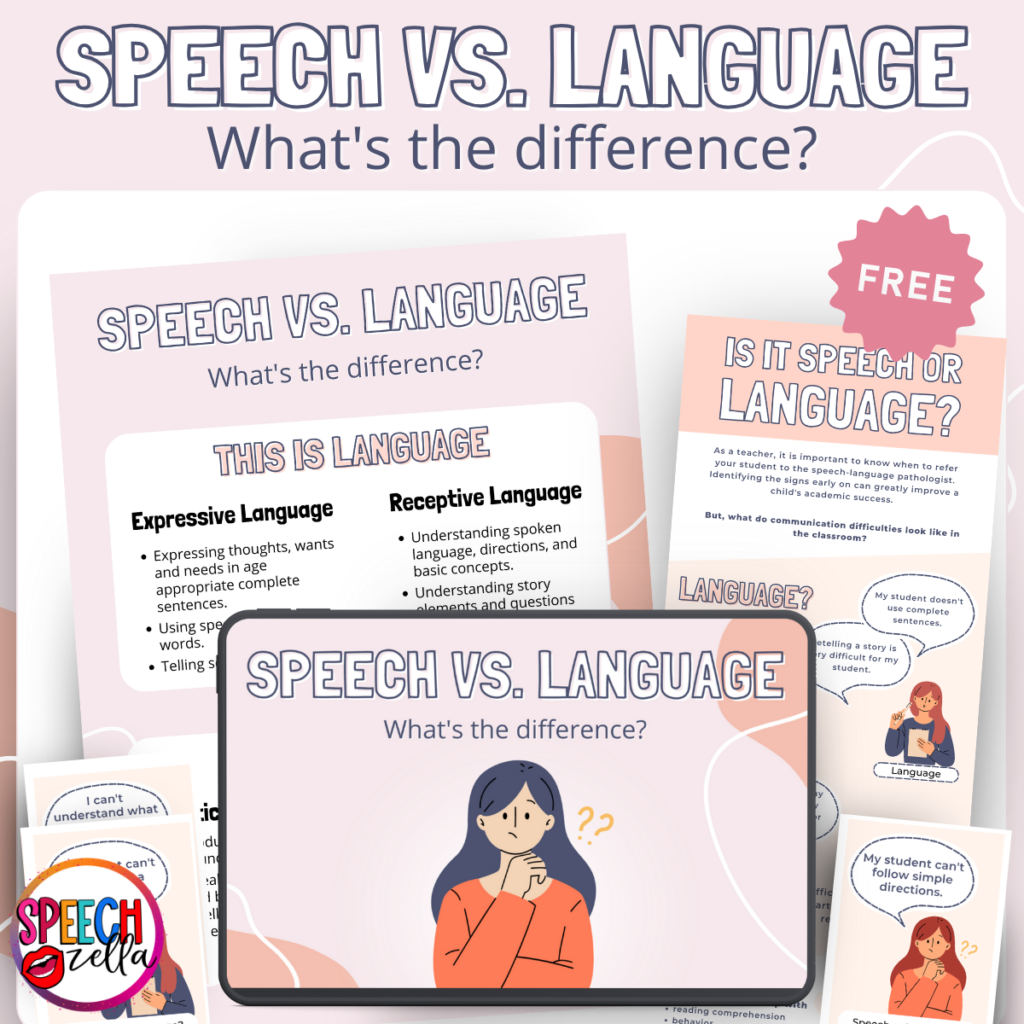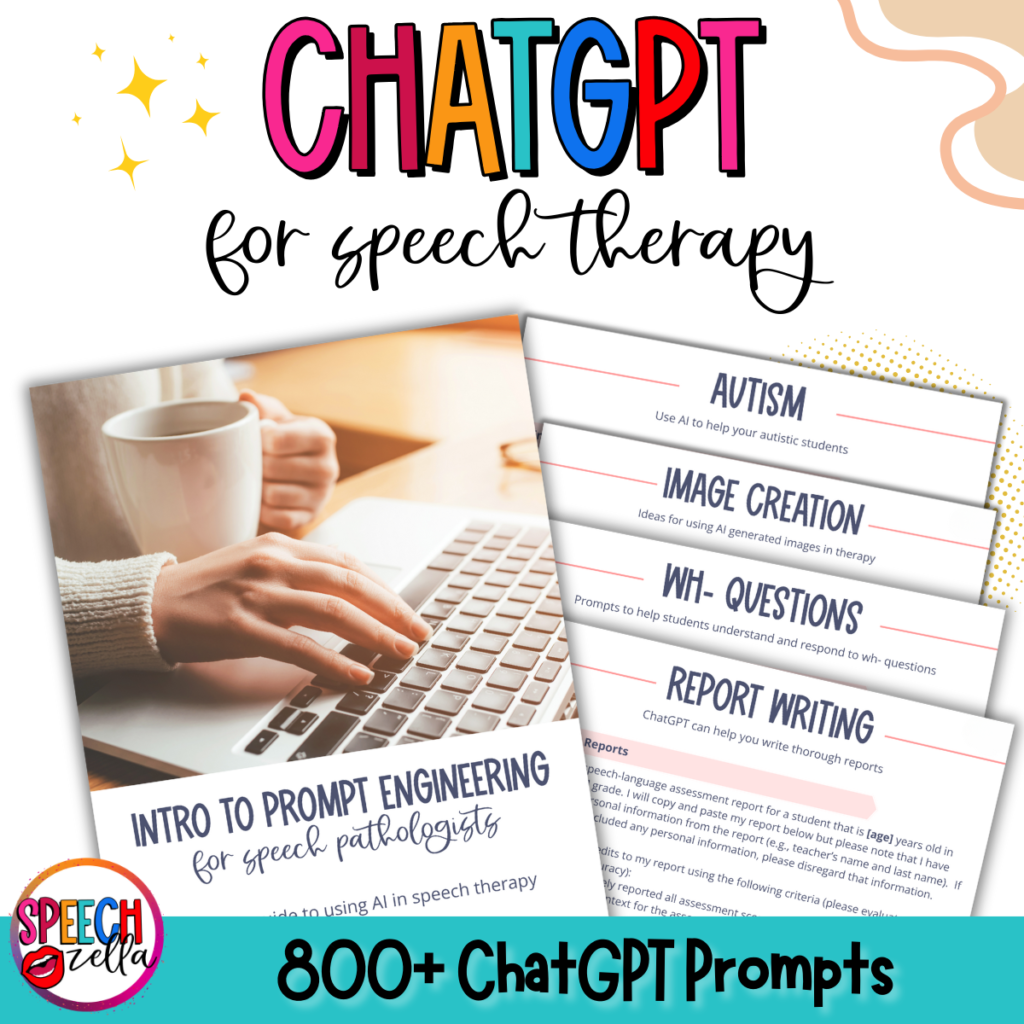How to Use Speech Therapy AI Prompts in ChatGPT
Ever wonder how you could use speech therapy AI prompts in ChatGPT? If so, keep reading to get my free guide to AI and ChatGPT for SLPs!
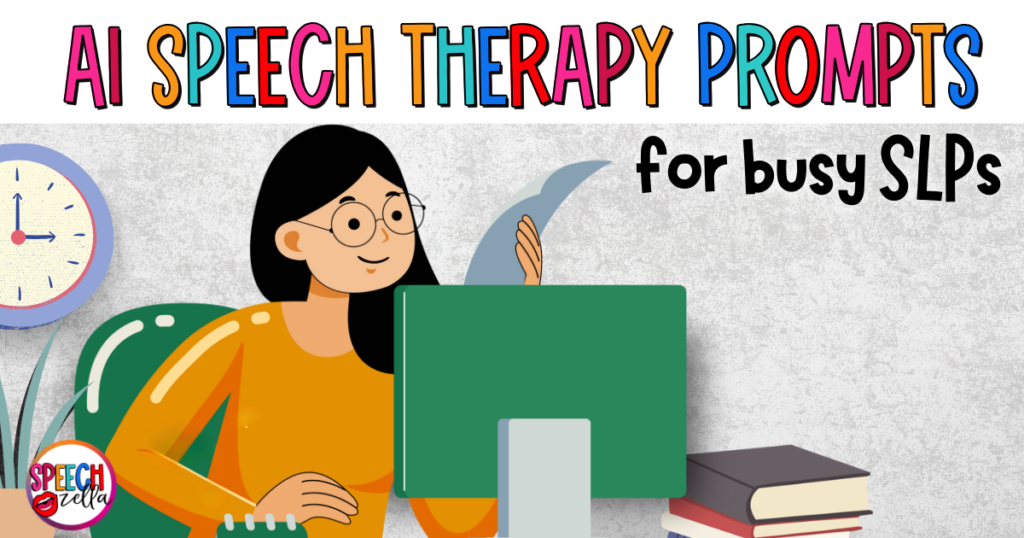
AI is changing so many fields, and speech therapy is no exception. By using AI, especially tools like ChatGPT, speech-language pathologists can create more personalized, engaging, and effective therapy sessions.
Guide to Speech Therapy AI Prompts
Whether you're an experienced SLP or a graduate student, this comprehensive AI guide to ChatGPT will make your job easier, more effective, and more creative.
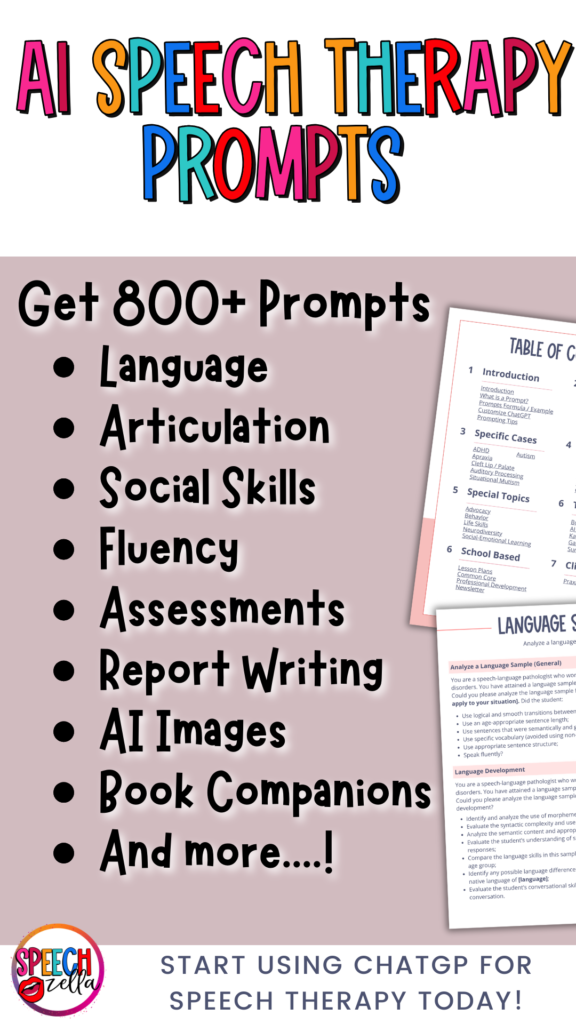
Imagine having over 800 ready-to-use prompts at your fingertips—just for speech therapists! This guide simplifies the planning process and gives you the tools to spark new ideas and engage your students in various ways.
From identifying speech patterns and understanding language development to more specialized areas like creating adapted books for communication disorders, autism support, and report writing—I've got it all covered!
If you’re still wondering if this resource is right for you, don’t miss out on the free ChatGPT SLP guide, which includes 100+ prompts to get you started.
Get the Complete Guide Today!
This complete guide was created for speech pathologists who are new to AI technology, as well as those looking for advanced strategies and prompts.
Keep reading to discover how this guide can transform your practice, streamline your workload, and bring fresh ideas to your therapy sessions!
Understanding AI-Powered Tools
Artificial Intelligence (AI) is helping speech therapists work to save time on repetitive tasks, create personalized therapy plans, and keep students more engaged in their therapy sessions. This powerful tool won’t replace therapists but will help improve your therapy sessions, get creative ideas, and save you time.
If you want even more information about AI, ChatGPT and the SLP, check out my other AI blog post. Check out this blog post if you want to learn more about the different chatbots and options. Seasoned SLPs and graduate students will find these prompts so helpful!
How Can AI Help with Speech Therapy?
AI is changing the game in speech therapy by giving real-time feedback and creating personalized plans to help people improve their speech patterns and overall communication skills. Because AI uses machine learning and natural language processing to understand small details in how someone speaks.
This helps therapists see progress and make changes to their approach as needed.

With these AI tools, therapists can also provide early intervention for younger kids, which helps boost their language development.
This is where my ChatGPT Prompt Book comes in handy, offering ready-made prompts that match different therapy goals.
Using generative AI is like having a personal assistant who will personalize your therapy sessions in just a few seconds.
For example, AI can help generate specific exercises for different speech issues, track progress, and even suggest modifications based on real-time feedback.
AI can process large amounts of data quickly and can help you analyze your student's progress toward meeting their goals.
It could even give you insight and recommend what other language skills you can target and create treatment plans. If your students like games, AI can help you find engaging activities and games to help make learning fun.
Introduction to ChatGPT for SLPs
Chat GPT is a chatbot that can generate text when asked questions or tasks are given to complete. My ChatGPT is a great tool that I use all the time to get new and fresh ideas for the speech room.
ChatGPT is trained on a large dataset, which means it can be very knowledgeable, even about specific topics related to speech-language pathology. Your questions (or prompts) can be as niched or general as you need them to be. You just have to make sure to ask the right questions.
Getting Started with ChatGPT
Setting up ChatGPT is easy – just log in from www.openai.com with your Google account.
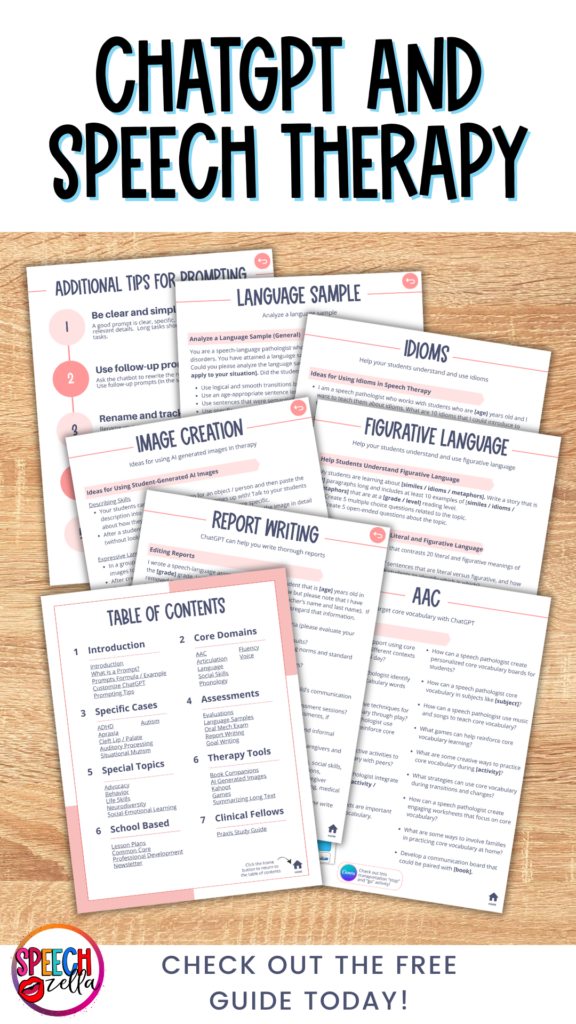
Firstly, you need to set up your custom instructions. You want ChatGPT to know as much about you as possible so that you can get better results from your searches and tasks.
Secondly, with my comprehensive and easy-to-follow training guide, you can set up custom instructions to help ChatGPT give you accurate and relevant responses.
With my full guide, you’ll get a Google Doc with customizable instructions that you can easily cut and paste into ChatGPT.
This easy-to-fill-out template is available with my complete guide to AI in speech therapy, so ChatGPT knows more about who you are and what you are looking for.
The chatbot will drive the narrative geared towards you.
What Exactly is a Prompt?
In speech pathology, prompts are cues or guiding steps we provide to help students form their responses. These prompts follow a hierarchy, gradually decreasing the level of support to encourage independence.
In AI, a prompt is a question, task, or information that helps the AI respond correctly. Similar to speech therapy, there’s also a system to build up prompts for AI.
- The speech therapist provides a prompt, like a question or task.
- The chatbot uses information from earlier conversations to understand and respond.
- Simple prompts lead to more complex ones.
- Then, the chatbot creates responses based on the prompt.
- Because of this, the chatbot can learn from the information provided in previous conversations.
Example of Hierarchical Interaction with AI
When interacting with AI, we can use different levels of prompts to guide responses, similar to how we use prompts in speech therapy. For example, here's how the hierarchy might look with AI:
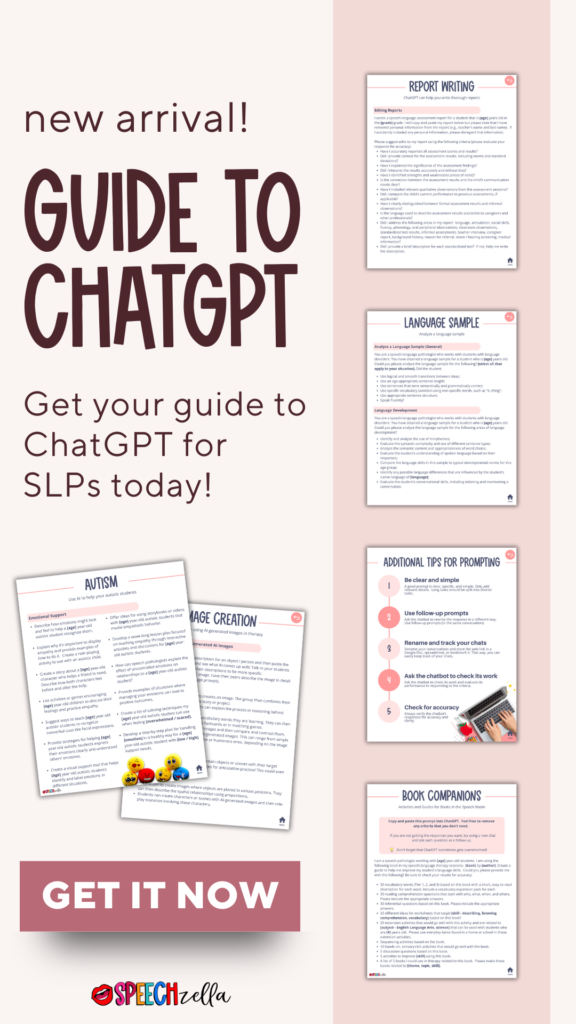
High Support
- User: “Translate ‘Good morning' to Spanish.”
- AI: “‘Good morning' in Spanish is ‘Buenos días.'”
Moderate Support
- User: “How do you greet someone in Spanish in the morning?”
- AI: “In the morning, you can greet someone in Spanish by saying ‘Buenos días.'”
Low Support
- User: “I'm learning Spanish. Any tips for greetings?”
- AI: “For greetings, you can start with ‘Hola' for ‘Hello,' ‘Buenos días' for ‘Good morning,' and ‘Buenas tardes' for ‘Good afternoon.'”
Minimal Support
- User: “Tell me about Spanish greetings.”
- AI: “Spanish greetings vary by time of day and formality. Common greetings include ‘Hola' for ‘Hello,' ‘Buenos días' for ‘Good morning,' ‘Buenas tardes' for ‘Good afternoon,' and ‘Buenas noches' for ‘Good evening' or ‘Good night.'”
AI handles prompts in a step-by-step way, similar to a hierarchy.
This means it can handle everything from clear instructions to open-ended questions, changing its response based on how much help and information it gets.
Therefore, this structured way of interacting allows the AI to help users effectively, just like speech therapists use different levels of prompts to guide their clients toward being more independent.
Creating the Perfect Prompt for ChatGPT
When using ChatGPT, create clear and effective prompts for the best results. ChatGPT can now remember previous conversations, which means it can use that context to give you more accurate and helpful responses. Everything you type into the chatbot becomes part of its memory, allowing for more personalized and relevant interactions over time.
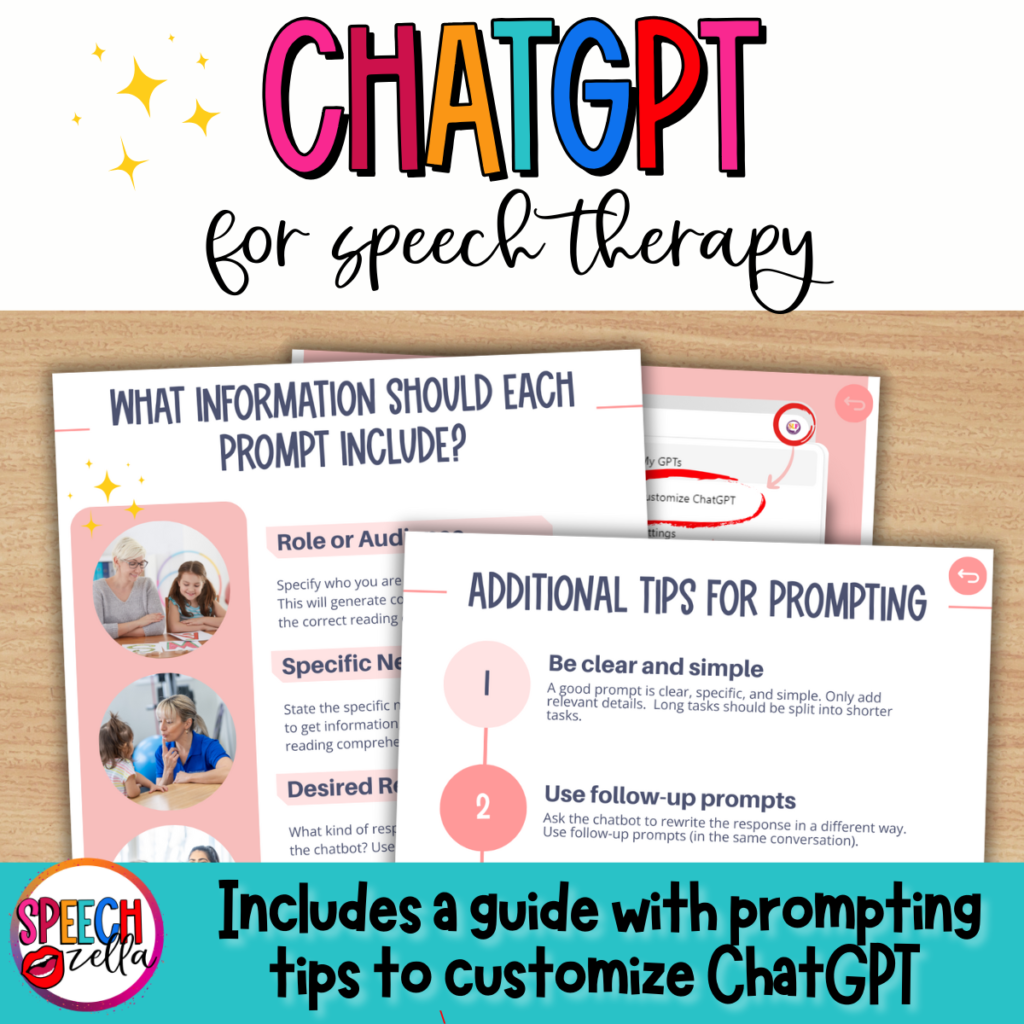
In short, to create an effective prompt for ChatGPT, focus on being clear and specific.
By doing so, you can ensure that ChatGPT provides relevant responses to your students' needs and goals.
If you want more tips on writing great prompts, check out my guide to using AI in speech therapy. It covers additional strategies and examples to help you make the most out of ChatGPT.
What are Some Speech Therapy AI Prompts?
Here are some practical AI applications and examples of speech therapy AI prompts you can use in ChatGPT today! To get even more prompts, check out my full guide today!
Articulation Practice
Need to practice articulation? Here are some prompts to get you started. For example:
- “Generate lists of words that include the /r/ sound in the initial, medial, and final position of the word.”
- “Create a list of 100 words related to superheroes that contain the /s/ sound.”
- “My students present with speech-sound disorders. What are the best ways to functionally target the /ch/ sound?”
- “Generate 20 sentences that include the /r/ sound in the initial, medial, and final position of words. Please use alliteration as much as possible.”
- “What speech patterns are typical and expected for 3-year-olds?”
Do you want more free resources? Check out my free vocalic /r/ worksheets for articulation therapy blog post to get free Canva resources for articulation!
Language Therapy
Use ChatGPT to help you provide better therapy sessions and get ideas for students with language disorders materials.
- “Provide examples of activities to teach young children how to categorize fruits and vegetables.”
- “You are on sequencing with your 3rd grade students. What are the steps for building a snowman?”
- “How can you target a student's language skills with books like “How to Catch the Easter Bunny?” (click the link to go to my “How to Catch the Easter Bunny blog post!)
- “Create 20 inferencing questions to help my 2nd grade student work on inferencing.”
- “Can you think of some therapy materials I can use to target verbs in my speech therapy practice?”
Early Intervention
Get ideas for working with toddlers who are under the age of 3 with the use of AI and ChatGPT:
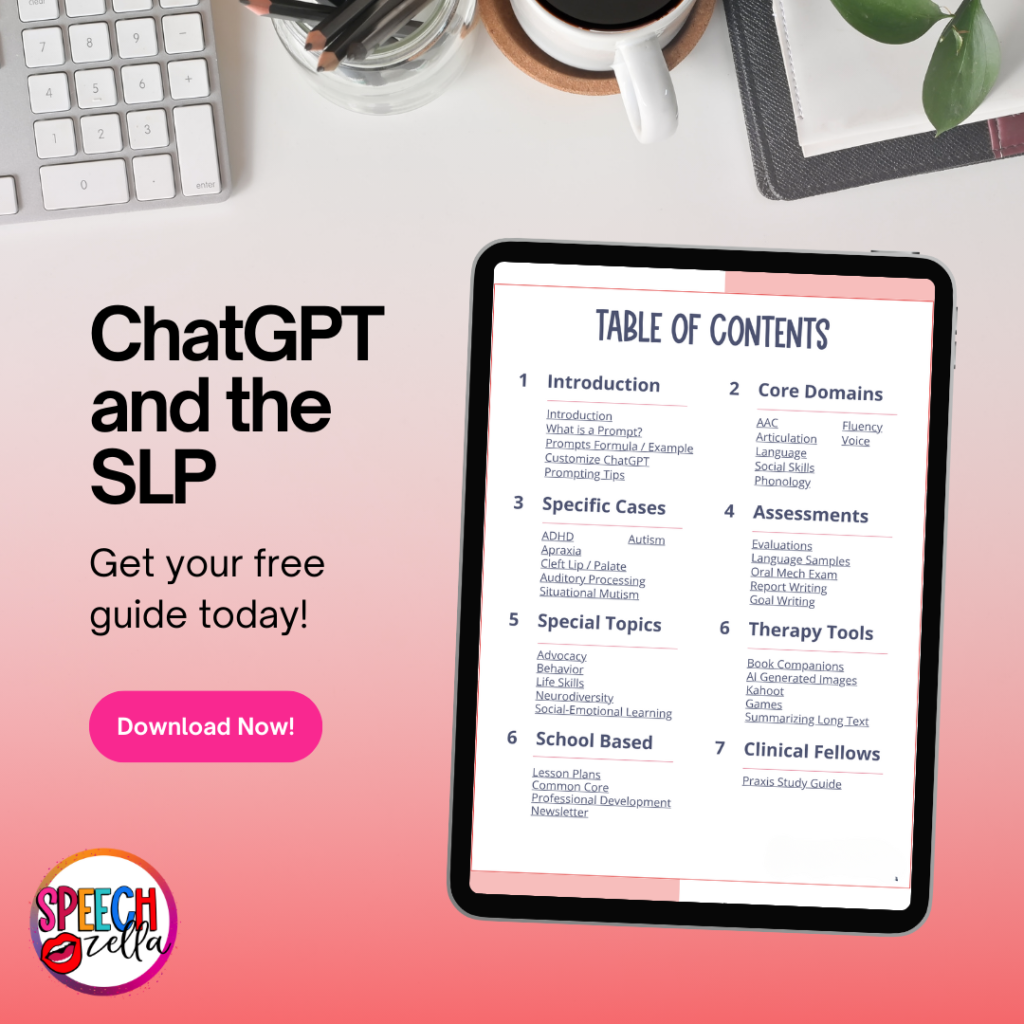
- “Describe 10 interactive storytelling activities that can support language development in toddlers.”
- “List 10 sensory play activities that can support language development in toddlers.”
- “How can I teach toddlers the names of common household items? Provide 10 creative activities.”
- “How can I use pretend play to encourage language development in toddlers? Provide 10 examples.
Stuttering
Help your stutterers with their fluency skills with these prompts:
- “How can I use pretend play to support speech fluency in toddlers with stuttering? Provide 10 examples.”
- “Generate 10 activities that can help older students with stuttering improve their speech fluency.”
- “Generate 10 ideas for using controlled breathing exercises to help older students with stuttering improve fluency.”
- “Describe 10 strategies for teachers to create a supportive speaking environment for older students with stuttering.”
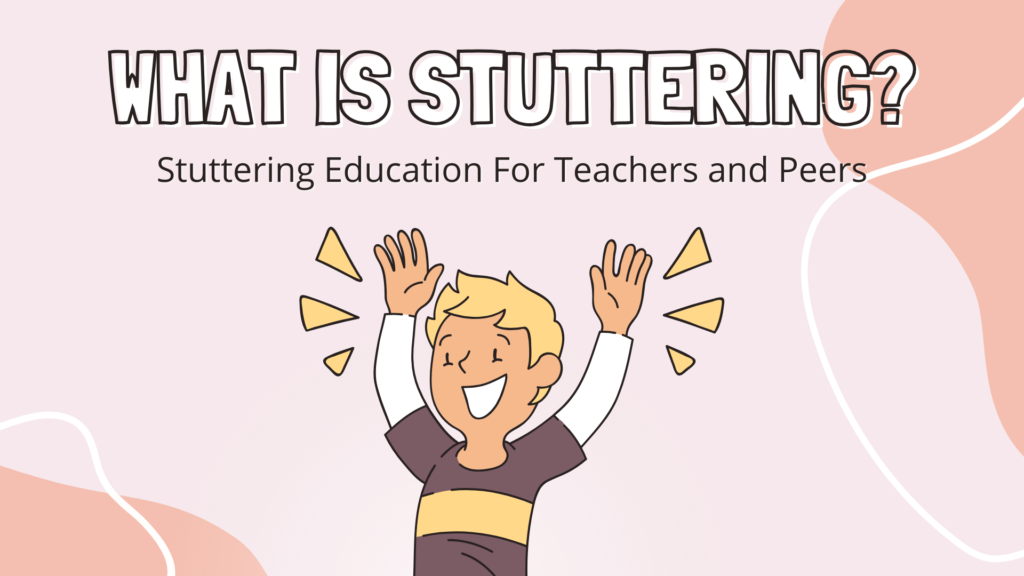
Learn more about stuttering with this free and editable Canva Presentation template that explains what Stuttering is!
Social Skills
You play a vital role in helping autistic students with their social skills while supporting their neurodiversity. Here are some speech therapy AI prompts you can use to help your students with their social skills:
- “Generate 10 activities to help autistic students recognize and express different emotions.”
- “Generate 10 interactive games that encourage turn-taking and sharing for autistic students.”
- “How can I incorporate visual schedules and social stories to support communication skills in autistic students? Provide 10 ideas.”
- “Generate 10 role-playing activities that teach problem-solving and conflict resolution to autistic students.
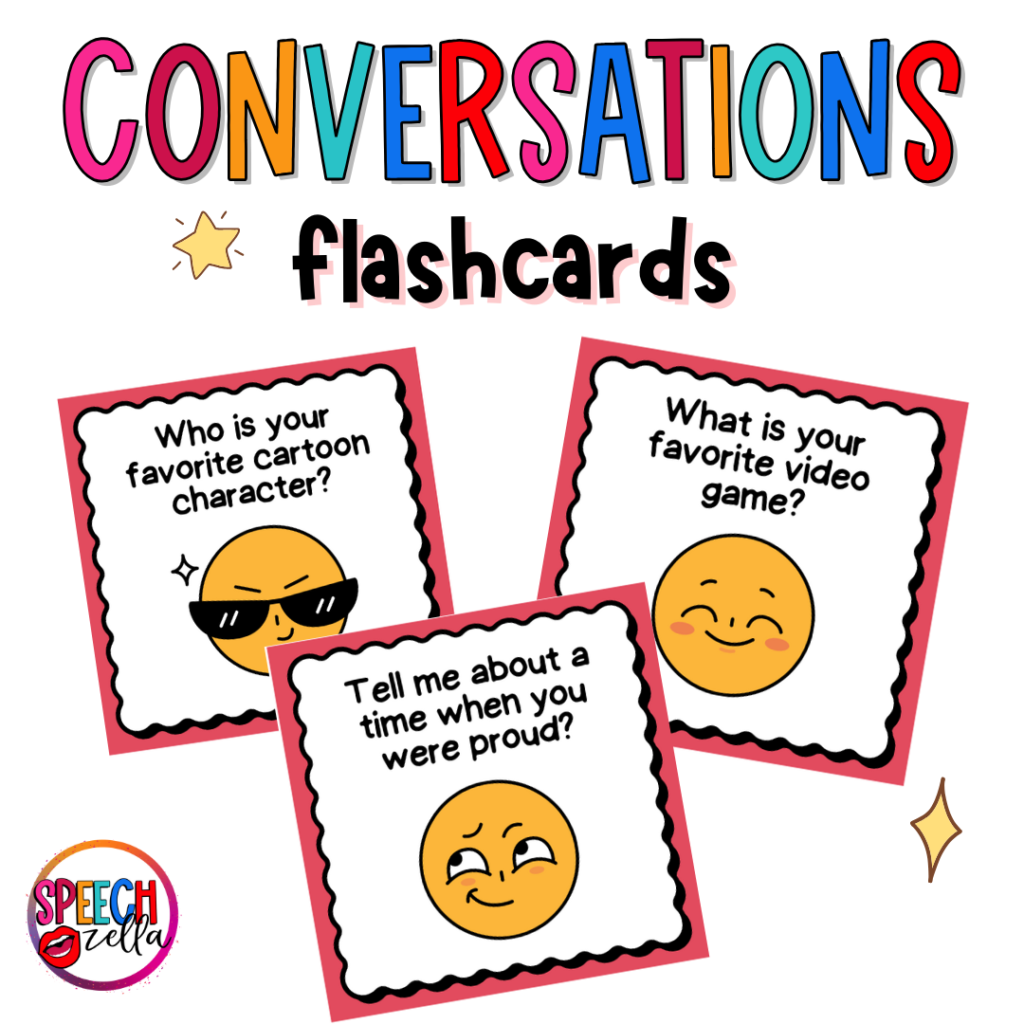
If you want free editable conversation starter cards, then check out my free Canva template!
How Can AI Be Used in Speech Therapy?
There are so many use cases for AI in speech therapy! Here are some ways that the power of AI can help you with everyday tasks when working with students with language impairments:
Personalized Therapy Plans
Provide ChatGPT with information about your student's specific needs to create customized therapy plans. For example:
- “Create a week-long therapy plan to improve vocabulary for a 7-year-old student.”
- “Provide 10 role-playing scenarios to help a student practice initiating conversations.”
- “Generate a week-long lesson plan using sensory activities to enhance vocabulary development in early elementary students.”
- “Generate a month-long lesson plan to support language development in preschoolers through themed activities. My student is interested in cars, trains, and blocks. Please incorporate my student's interests into the lesson plan.”
Progress Tracking and Reporting
If you ever stared at a progress report and wondered what to write next, then let ChatGPT help you! Here are some prompts you can use to help you analyze data from therapy sessions.
- “My 5 year old student has been working on building his vocabulary skills in speech therapy sessions. I collected the data from my therapy sessions [insert data here]. Can you summarize his progress in achieving this goal?”
- “Create a template for a monthly progress report to share with parents about their child's vocabulary development.”
- Generate a comprehensive progress tracking and reporting template for speech articulation therapy targeting the /s/ sound.
Interactive and Engaging Sessions
AI can generate interactive exercises that keep your students engaged. For example:
- Create a list of 10 cooperative games that encourage turn-taking and social interaction for middle school students with autism.
- “Provide 10 sensory play activities that can support language development in preschoolers.”
- “Generate 10 ideas for using apps and digital tools to create engaging speech therapy activities.”
- “Generate 10 music and movement activities that can help preschoolers with language development.”
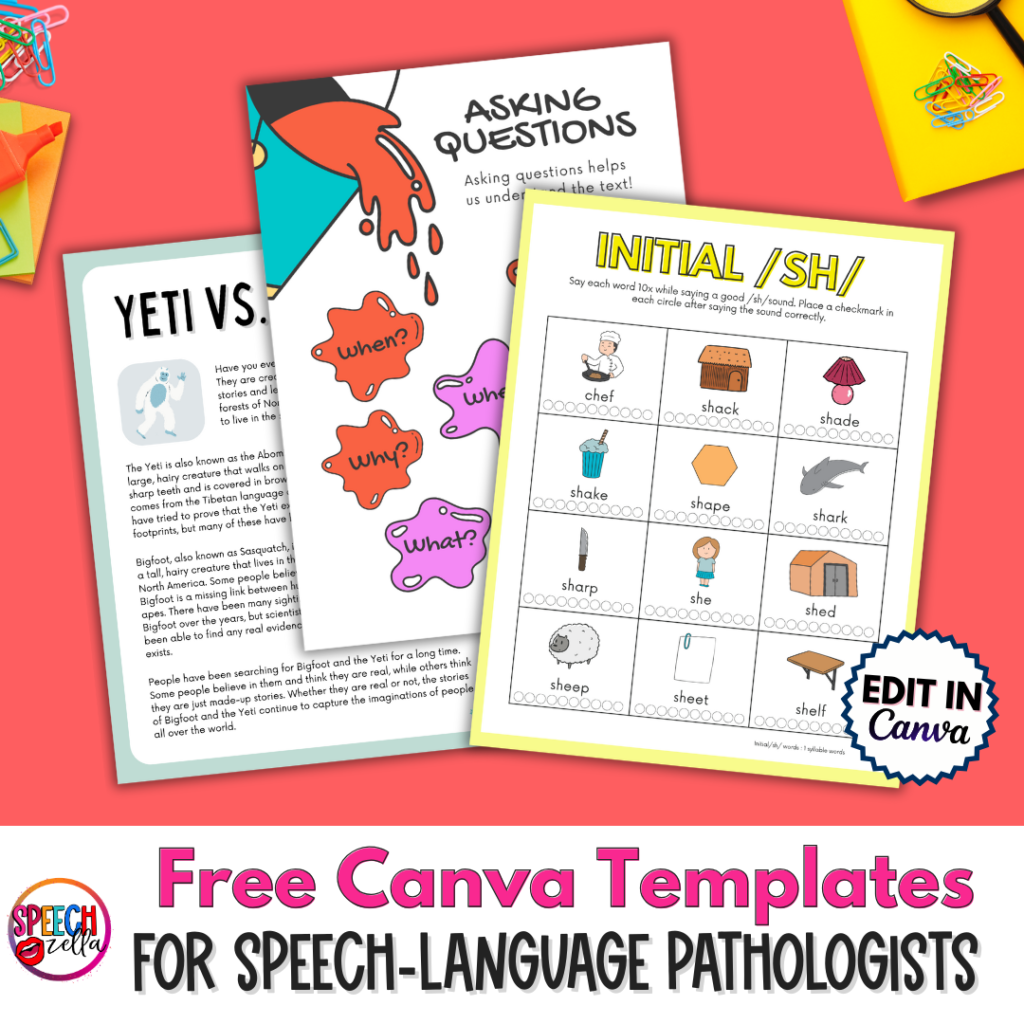
If you want more freebies, then sign up for my newsletter to get all the new Canva templates in your inbox!
AI Screening Tools
Surprisingly, you can even create a screening tool in ChatGPT! Here are some ways to prompt the chatbot to help you write assessments, gather information, and find therapy techniques today.
- “Generate a comprehensive screening questionnaire for assessing speech and language development in preschool children.”
- “Create a set of interview questions to ask parents when evaluating their child's speech and language skills.”
- “Generate an observational checklist to screen for potential speech and language issues during a classroom observation.”
- “Create a self-assessment questionnaire for high school students to assess their fluency skills.”
- “Generate a template for summarizing the results of a speech and language screening.”
- “Suggest follow-up activities for students who show potential language development delays during screening. The student struggled with the following skills: [include skills here]”
How do you come up with good AI PROMPTs?
If you want to know more tips and tricks for using ChatGPT in speech therapy, then check out my complete guide here:

Here are some tips for improving the output from ChatGPT:
- Be clear. A good prompt is clear and specific. Don’t add unnecessary details.
- Use follow-up prompts: Don’t be afraid to tweak ChatGPT’s responses.
- If a prompt doesn’t quite hit the mark, adjust it and try again. The more you interact, the better the responses.
- Keep conversations in one place: To get more relevant responses, keep all your questions related to a particular topic in one chat.
Ethical Considerations for AI in Speech Therapy
According to the American Speech-Language-Hearing Association’s code of ethics, we are responsible for using AI ethically. Here are some helpful tips to ensure that you protect the privacy of your students when using AI prompts in Speech Therapy:

Keep sensitive data confidential!
- The information you add to a chatbot can be used to train future AI models.
- Do not provide AI with identifying information (names, birthdates, etc.).
- Instead, use pseudonyms or first names only.
AI tools may produce inaccurate or unreliable results.
- Make sure to validate AI tools by cross-referencing with established, evidence-based articles / information.
- In addition, do not over-rely on AI tools.
- Nonetheless, AI tools should supplement, not replace, professional expertise.
AI tools might suggest interventions that are not aligned with current evidence-based practices.
- Being that, critically evaluate AI-generated recommendations against the latest research and clinical guidelines to ensure they are evidence-based.
ChatGPT can be biased.
- AI systems can inherit biases from the data they are trained on, which can lead to discrimination.
- Above all, evaluate AI output for bias, fairness, and equity.
Will SLPs Be Replaced by AI?
No, SLPs will not be replaced by AI—but they could be replaced by an SLP who knows how to use AI!
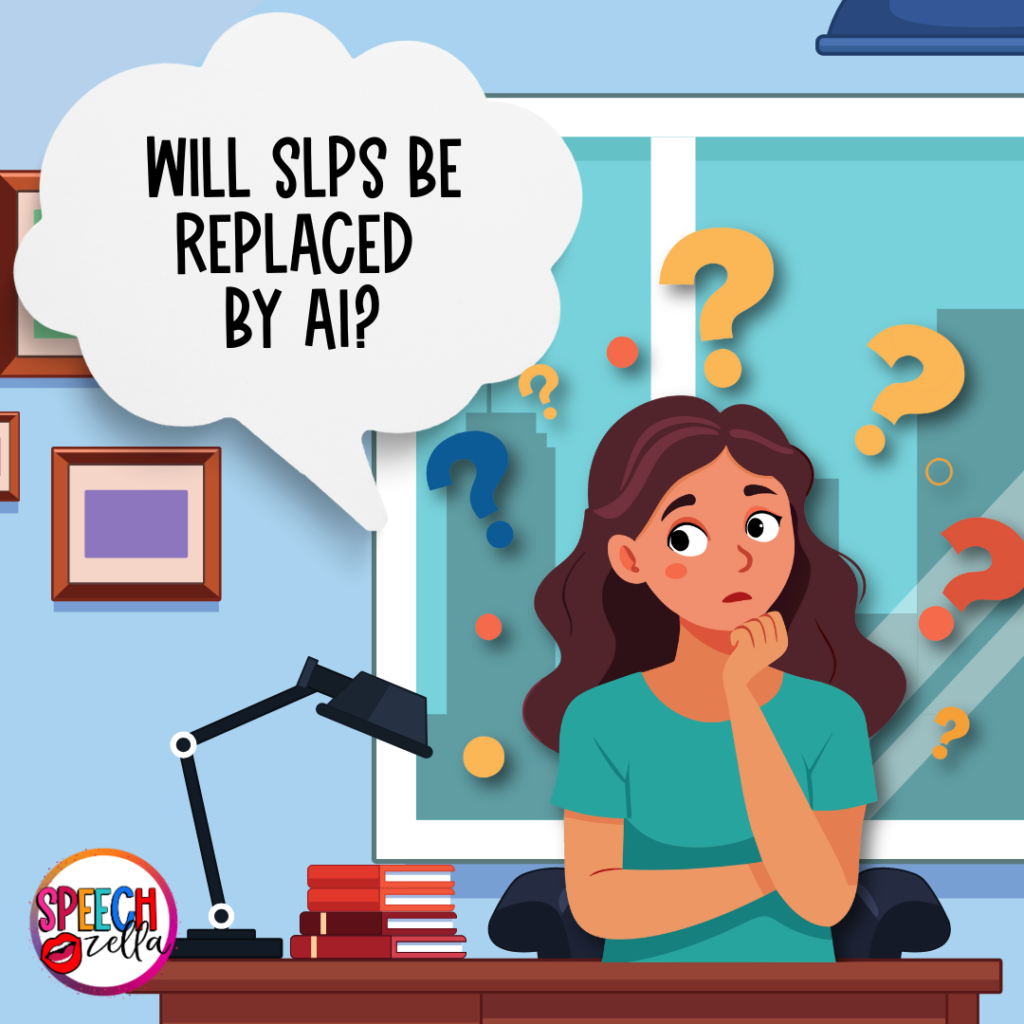
AI is not designed to take over a speech therapist’s role; instead, it acts as a powerful tool to support and enhance what therapists already do.
AI can handle lots of tasks. For instance, data collection and analysis, report writing / editing, creating therapy activities, and providing real-time feedback.
Additionally, SLPs can use AI to create personalized plans, find patterns in speech disorders, and make activities that help students with communication difficulties.
However, AI still relies on a skilled therapist to guide and use it correctly!
Lastly, SLPs who learn to use these new tools can make their work easier in less time, focusing on helping their students, patients, and clients more effectively.
Conclusion
In conclusion, AI is a game-changer for speech therapy. ChatGPT makes therapy sessions more effective and engaging, from personalized prompts to assessment tips.

Overall, using speech therapy AI prompts allows therapists to create customized exercises that cater to the individual needs of their patients, making therapy more dynamic and responsive.
Using AI, speech therapists can save time, improve their student's progress, and save money.
Why not give it a try? Head over to ChatGPT today and see how you can use ChatGPT as a valuable tool in your therapy toolkit.
But, also make sure you check out my complete guide to the SLP and Chatgpt!
If you want even more information about ChatGPT and SLPs, check out other blog post!

